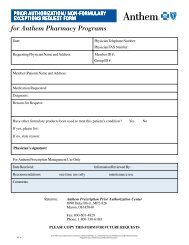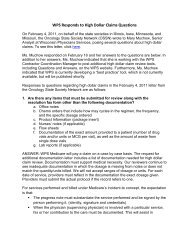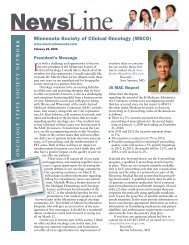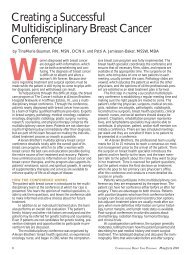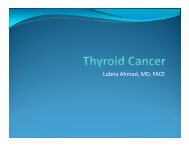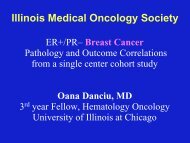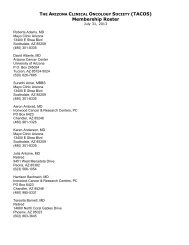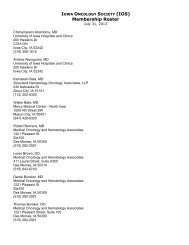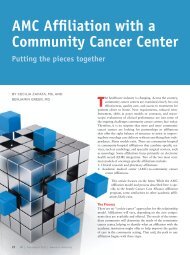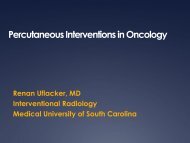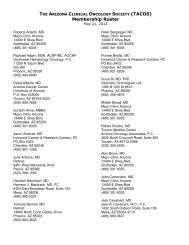Cancer Program Guidelines - Association of Community Cancer ...
Cancer Program Guidelines - Association of Community Cancer ...
Cancer Program Guidelines - Association of Community Cancer ...
Create successful ePaper yourself
Turn your PDF publications into a flip-book with our unique Google optimized e-Paper software.
Rationale<br />
Palliative care is the active intervention to achieve the maximum<br />
comfort and function <strong>of</strong> the total patient. Palliation<br />
(relief <strong>of</strong> symptoms) should always be an important part <strong>of</strong><br />
patient care. In the advanced cancer patient, it may be the<br />
only care when curative care is no longer the goal. Palliative<br />
care should attend to the physical, emotional, psychological,<br />
social, cultural, and spiritual needs <strong>of</strong> the patient.<br />
Characteristics<br />
A. Palliative care is an integral part <strong>of</strong> the comprehensive<br />
spectrum <strong>of</strong> patient care.<br />
B. Palliative care is available when curative treatment is no<br />
longer considered a goal.<br />
C. Pr<strong>of</strong>essional staff is educated about the physical, emotional,<br />
spiritual, and psychosocial components <strong>of</strong> palliative<br />
care in relieving suffering and providing comfort at<br />
the end <strong>of</strong> life.<br />
D. Palliative care is a multidisciplinary effort, involving<br />
physicians, nurses, social workers, clergy, and other<br />
members <strong>of</strong> the healthcare team, to maximize comfort<br />
and support that respects the patient’s wishes, values,<br />
culture, and traditions.<br />
E. Palliative care requires continuous, effective communication<br />
with the patient and his or her family to ensure<br />
that goals are mutually set and understood by the multidisciplinary<br />
team, the patient, and his or her family.<br />
F. Pr<strong>of</strong>essional staff has a responsibility to discuss, with<br />
the patient and his or her family, issues such as withholding/withdrawing<br />
various therapeutic measures,<br />
artificial feeding and hydration, cardiopulmonary resuscitation,<br />
and any other measures that may impact the<br />
patient’s quality <strong>of</strong> life.<br />
Section 14<br />
Hospice<br />
Guideline I<br />
A hospice program exists to provide pr<strong>of</strong>essional<br />
and volunteer services to patients with cancer in the<br />
terminal stage <strong>of</strong> disease and their families. Bereavement<br />
support for families is provided for a minimum <strong>of</strong> six<br />
months.<br />
Rationale<br />
The palliative and supportive services <strong>of</strong> a hospice program<br />
provide physical, psychosocial, and spiritual care for patients<br />
with terminal cancer diagnoses and their families.<br />
Characteristics<br />
A. Multidisciplinary hospice services are available to dying<br />
patients and their families and include home-based<br />
hospice, inpatient hospice, residential hospice or respite<br />
care. Services provided include medical, nursing,<br />
psychosocial, spiritual, and bereavement. Services may<br />
be provided by hospice program staff, volunteers, or<br />
through a written agreement(s) with an individual,<br />
institution, or agency.<br />
B. The hospice program assures continuity <strong>of</strong> care through<br />
assessment <strong>of</strong> the patient and family needs, development<br />
and review <strong>of</strong> the care plan, and management <strong>of</strong> care<br />
needs until discharge or until death and the bereavement<br />
period.<br />
C. Hospice services are available 24 hours a day, 7 days a<br />
week.<br />
D. Homemaker and home health aide services are available.<br />
E. Acute and chronic cancer pain management is available<br />
to all patients. (See Chapter 4, Section 7, Pain Management.)<br />
F. A medical staff or director is responsible for the supervision<br />
and quality <strong>of</strong> hospice services.<br />
G. Hospice services are provided with sufficient nursing<br />
personnel to meet the level <strong>of</strong> care required by hospice<br />
patients.<br />
H. Respite care is available to family and other caregivers.<br />
I. The hospice program meets appropriate licensing and<br />
accreditation requirements.<br />
J. Policies and procedures are established for all hospice<br />
components including: admission and discharge criteria,<br />
bereavement care, and psychosocial, medical and<br />
nursing care management.<br />
Section 15<br />
Pastoral Care<br />
Guideline I<br />
Pastoral care services are available to meet the needs<br />
<strong>of</strong> all patients and their families with consideration <strong>of</strong><br />
diversity in religious preferences.<br />
Rationale<br />
Spiritual and psychological issues are confronted by cancer<br />
patients and their families, staff members, and the community<br />
at-large; therefore, effective pastoral care is an integral<br />
part <strong>of</strong> relating to such issues. Staff respects the personal<br />
integrity, spiritual beliefs, and traditions <strong>of</strong> each individual<br />
and assists in creating an environment <strong>of</strong> acceptance,<br />
reflection, and expression <strong>of</strong> spiritual needs.<br />
Characteristics<br />
A. Pastoral care is supervised by a qualified pr<strong>of</strong>essional<br />
chaplain with appropriate education (college and accredited<br />
theological school) and clinical training (four units<br />
<strong>of</strong> clinical pastoral education are preferred).<br />
B. Spiritual needs may be identified and referred to a pr<strong>of</strong>essional<br />
chaplain by all members <strong>of</strong> the oncology team.<br />
ACCC <strong>Cancer</strong> <strong>Program</strong> <strong>Guidelines</strong> Chapter 4 Clinical Management and Supportive Care Services 23



